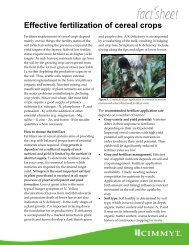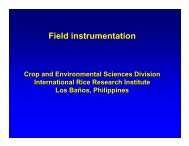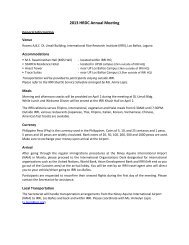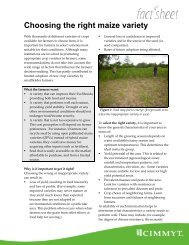Water management in irrigated rice - Rice Knowledge Bank ...
Water management in irrigated rice - Rice Knowledge Bank ...
Water management in irrigated rice - Rice Knowledge Bank ...
- No tags were found...
Create successful ePaper yourself
Turn your PDF publications into a flip-book with our unique Google optimized e-Paper software.
consumption (Hamilton 2003). Many traditionalfestivals and religious practices are associated with<strong>rice</strong> cultivation and <strong>rice</strong> fields are valued for theirscenic beauty.4.2 Environmental impactsThe production of lowland <strong>rice</strong> affects the environment<strong>in</strong> negative ways, such as the emissionof greenhouse gases and water pollution. In thissection, environmental impacts that have a relationshipwith water and the hydrology of <strong>rice</strong> fields aresummarized.4.2.1 Ammonia volatilizationAmmonia (NH 3) volatilization from urea fertilizeris the major pathway of N loss <strong>in</strong> tropical flooded<strong>rice</strong> fields, often caus<strong>in</strong>g losses of 50% or more ofthe applied urea-N (Buresh and De Datta 1990).Ammonia-N emissions from lowland <strong>rice</strong> fields areestimated to be roughly 3.6 Tg per year (comparedwith a total of 9 Tg y −1 emitted from all agriculturalfields), which is some 5−8% of the estimated 45−75Tg of globally emitted ammonia-N per year (Kirk2004). The magnitude of ammonia volatilizationlargely depends on climatic conditions, field waterstatus, and the method of N fertilizer application.Volatilized ammonium can be deposited on theearth by ra<strong>in</strong>, which can lead to soil acidification(Kirk 2004) and un<strong>in</strong>tended N <strong>in</strong>puts <strong>in</strong>to naturalecosystems.4.2.2 Greenhouse gasesIrrigated <strong>rice</strong> systems are a significant s<strong>in</strong>k for atmosphericCO 2(Chapter 4.1), a significant sourceof methane (CH 4), and a small source of nitrousoxide (N 2O). In the early 1980s, it was estimatedthat lowland <strong>rice</strong> fields emitted some 50−100 Tgof methane per year, or about 10−20% of the thenestimated global methane emissions (Kirk 2004).Recent measurements, however, show that many<strong>rice</strong> fields emit substantially less than those <strong>in</strong>vestigated<strong>in</strong> the early 1980s, especially <strong>in</strong> northern Indiaand Ch<strong>in</strong>a. Also, methane emissions have actuallydecreased s<strong>in</strong>ce the early 1980s because of changes<strong>in</strong> crop <strong>management</strong> such as a decreased use oforganic <strong>in</strong>puts (Van der Gon et al 2000). Currentestimates of annual methane emissions from <strong>rice</strong>fields are <strong>in</strong> the range of 20 to 60 Tg, be<strong>in</strong>g 5–10%of total global emissions of about 600 Tg (Kirk2004). The magnitude of methane emissions from<strong>rice</strong> fields is ma<strong>in</strong>ly determ<strong>in</strong>ed by water regime andorganic <strong>in</strong>puts, and to a lesser extent by soil type,weather, tillage, residue <strong>management</strong>, fertilizer use,and <strong>rice</strong> cultivar (Bronson et al 1997a,b, Wassmannet al 2000). Flood<strong>in</strong>g of the soil is a prerequisitefor susta<strong>in</strong>ed emissions of methane. Mid-seasondra<strong>in</strong>age, a common irrigation practice adopted <strong>in</strong>major <strong>rice</strong>-grow<strong>in</strong>g regions <strong>in</strong> Ch<strong>in</strong>a and Japan,greatly reduces methane emissions. Similarly,<strong>rice</strong> environments with an uneven supply of water(for example, those suffer<strong>in</strong>g from water scarcity,Chapter 1.7) have a lower emission potential thanfully <strong>irrigated</strong> <strong>rice</strong>.Few accurate assessments have been made ofemissions of nitrous oxide from <strong>rice</strong> fields (Abao etal 2000, Bronson et al 1997a,b, Dittert et al 2002),and the contribution to global emissions has not yetbeen assessed. In <strong>irrigated</strong> <strong>rice</strong> systems with goodwater control, nitrous oxide emissions are quitesmall except when excessively high fertilizer-Nrates are applied. In <strong>irrigated</strong> <strong>rice</strong> fields, nitrousoxide emissions ma<strong>in</strong>ly occur dur<strong>in</strong>g fallow periodsand immediately after flood<strong>in</strong>g of the soil at the endof the fallow period.4.2.3 <strong>Water</strong> pollutionChanges <strong>in</strong> water quality associated with <strong>rice</strong> productionmay be positive or negative, depend<strong>in</strong>gma<strong>in</strong>ly on <strong>management</strong> practices such as fertilizationand biocide (all chemicals used for crop protection,such as herbicides, pesticides, fungicides, etc.)use. The quality of the water leav<strong>in</strong>g <strong>rice</strong> fields maybe improved as a result of the capacity of the <strong>rice</strong>fields to remove nitrogen and phosphorus (Feng etal 2004, Ikeda and Watanabe 2002). On the otherhand, nitrogen transfer from flooded <strong>rice</strong> fields bydirect flow of dissolved nitrogen through runoffwarrants more attention. High nitrogen pollutionof surface fresh waters can be found <strong>in</strong> <strong>rice</strong>-grow<strong>in</strong>gregions where fertilizer rates are excessivelyhigh, such as <strong>in</strong> Jiangsu Prov<strong>in</strong>ce <strong>in</strong> Ch<strong>in</strong>a (Cuiet al 2000).Contam<strong>in</strong>ation of groundwater may arisefrom the leach<strong>in</strong>g of nitrate or biocides and theirresidues (Bouman et al 2002). Nitrate leach<strong>in</strong>gfrom flooded <strong>rice</strong> fields is quite negligible becauseof rapid denitrification under anaerobic conditions(Buresh and De Datta 1990). For example, <strong>in</strong> thePhilipp<strong>in</strong>es, nitrate pollution of groundwater under<strong>rice</strong>-based cropp<strong>in</strong>g systems surpassed the 10 mgL −1 limit for safe dr<strong>in</strong>k<strong>in</strong>g water only when highly36


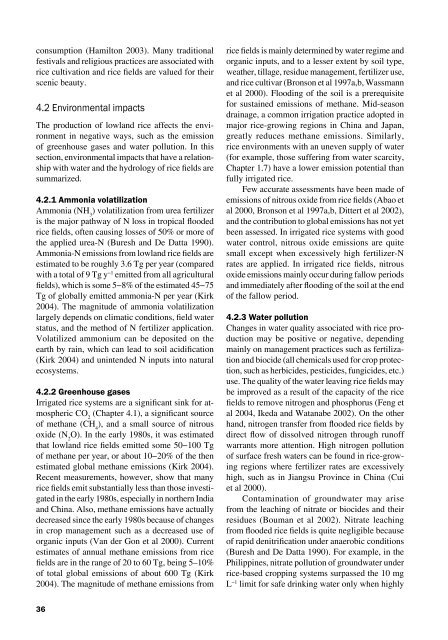


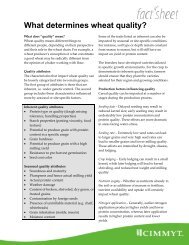

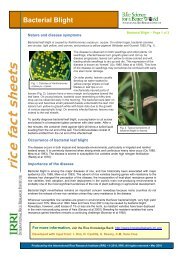

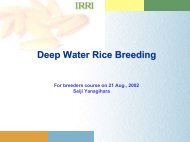
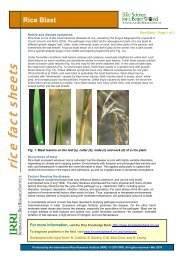
![International Standards' Organization â Rice Specification [ISO 7301]](https://img.yumpu.com/36696862/1/190x245/international-standards-organization-a-rice-specification-iso-7301.jpg?quality=85)

